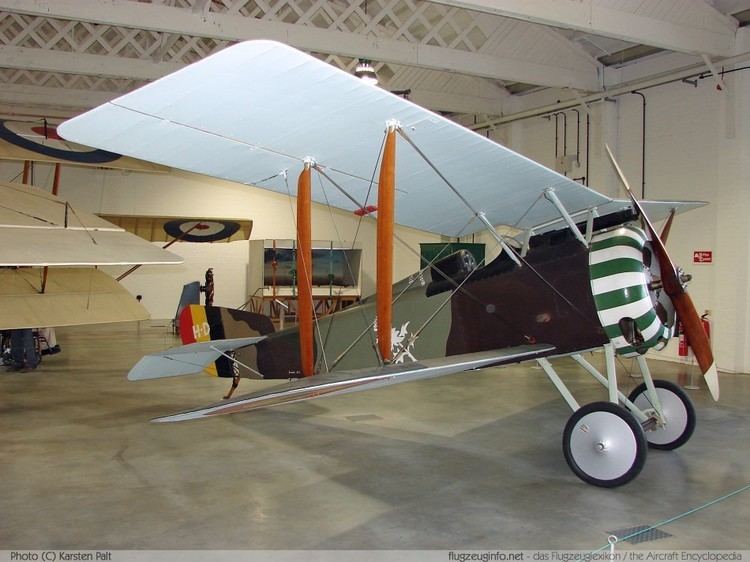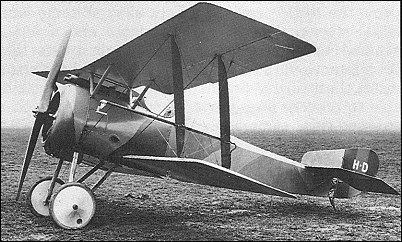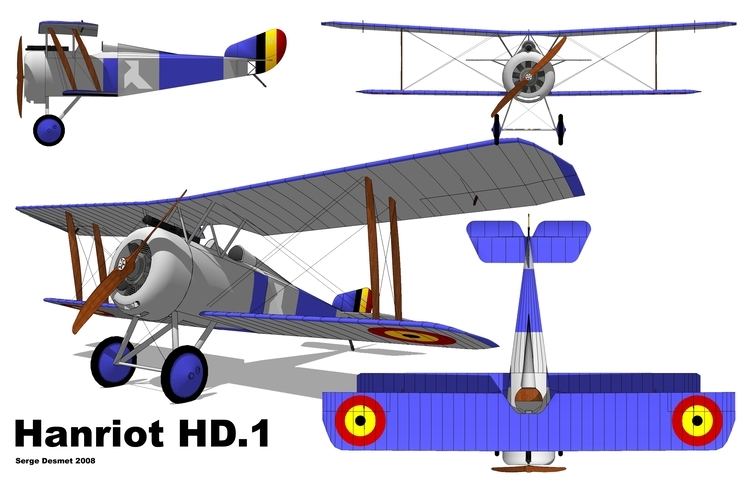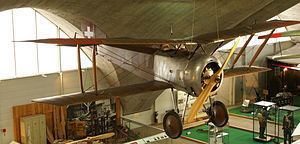Top speed 184 km/h Wingspan 7.77 m Weight 407 kg Manufacturer Hanriot | Range 550 km Length 5.85 m Engine type Le Rhône 9J | |
 | ||
Tval s 1917 french hanriot hd 1 aircraft in belgian colours
The Hanriot HD.1 was a French World War I single-seat fighter aircraft. Rejected for service with French squadrons in favour of the SPAD S.7, the type was supplied to the Belgian and the Italian air forces with whom it proved highly successful. Of a total of about 1,200 examples built, 831 were in fact produced by Italian companies under licence.
Contents
- Tval s 1917 french hanriot hd 1 aircraft in belgian colours
- Development and production
- Operational history
- Surviving aircraft
- Operators
- Specifications HD1
- References

Development and production
The Hanriot company produced a series of pioneering monoplanes pre-war, but had settled down as a licence manufacturer, notably of Sopwith 1½ strutters, when the HD.1 was produced in 1916.

The type was a conventional fighter with the general characteristics of a typical Sopwith type, being strongly but lightly built, and combining clean lines with a light wing loading. In particular, it used the same “1½” (or "W") cabane strut arrangement as the Sopwith two-seater. It had a flat lower wing, though the top wing had quite sharp dihedral.

On the power of its 110 hp (82 kW) Le Rhone rotary engine it was not outstandingly fast, but it was very manoeuvrable and proved popular with pilots as a safe and pleasant aircraft to fly. To maintain a competitive climbing and altitude performance it was usual practice to restrict armament to a single synchronised Vickers gun, although there was provision for a second gun, and one was occasionally fitted. In French built aircraft the gun (or guns) were fitted to the sides of the cockpit, and were accessible to the pilot without their butts being directly in front of his face in the event of a crash – an unusual but welcome feature, even if its origins lay in the form of the cabane struts. Italian-built versions, however, mounted a single machine gun centrally.

The type was also produced by the Nieuport-Macchi company of Varese, Italy, which built almost 900 HD.1s between 1917 and 1919; more than the parent firm.
Operational history

The new type was ordered into production as a possible replacement for the Nieuport 17, but became “surplus” when it was decided to replace the Nieuport with the SPAD S.7 in the French air service. Some were supplied to the French Navy, a few of which were eventually passed to the U.S. Navy – some naval Hanriots were converted to, or built as, floatplanes with enlarged tail surfaces.
The bulk of early production, however, was diverted to the Belgians, who notoriously had to make do with aircraft unwanted by their allies. With the Belgian fighter squadrons the HD.1 proved surprisingly successful, and the type remained the standard Belgian fighter for the rest of the war. Willy Coppens, the top Belgian ace of the war was the most successful HD.1 pilot. At least one of his machines was experimentally fitted with an 11mm Vickers machine-gun for use in balloon busting, something at which Coppens excelled. Most of his victories were balloons and many were claimed while flying various HD.1s. These aircraft remained in use until the late 1920s.
The type was also supplied in small numbers to the Italians who manufactured it in quantity, and used it to replace not only Nieuports but also SPADs in their service. The type was considered (by the Italians) to be a better all-round fighter than even the SPAD S.XIII and it became the standard Italian fighter, equipping 16 of the 18 operational Italian fighter squadrons by November 1918. Surplus Italian-built Hanriots were used by several countries postwar, including the Swiss.
The U.S. Naval Aircraft Factory built (or possibly modified/converted) 10 HD.1s in the immediate postwar years. These were mainly used as trainers, although they were also involved in experiments with takeoff platforms on warships – they could be fitted with twin guns, and at least one machine had a hydrovane and flotation bags of the type developed for the Royal Navy.
Surviving aircraft
Five examples of the HD.1 are preserved in museums in Europe and the USA:
Operators
Specifications (HD.1)
Data from Holmes, 2005. p 31.
General characteristics
Performance
Armament
